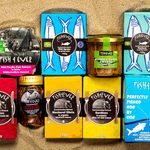You have no items in your shopping cart.
The word accounting in a title is bound to put off 90% of readers. That’s a shame – because you can’t do anything about your footprint without knowing what it is and what it comprises of, where the pinch points are and if there are any easy wins.
We thought it might be useful to give a very brief and potted outline of carbon emission accounting. But first let’s make another bigger point. I’m going to paraphrase what Mike Berners-Lee said in a Food Ethics Council Zoom conference I attended. Mike Berners Lee is a professor at Lancaster University and founder of Small World Consulting, which amongst other jobs, worked on the Brewdog net zero policy. I don’t like Brewdog but I do like Mike. He’s the author of “How Bad are Banana’s” – and if there’s one place to start on your learning journey about personal carbon footprint it’s there. The book is well researched but written in an easy and friendly way. On the Zoom call, Mike likened Co2 accounting to the early maps of the 15 th and 16 th century: they weren’t perfect but they were good enough to get exploring – and over time they got better. This is where carbon accounting is now. We shouldn’t be put off by unknowns and uncertainties. It’s a map to help us get to where we want to be.
So here I’m going to look at two major Co2 accounting points:-
- Organisation versus product footprint
- Lifecycle analysis
Organisation Versus Product Footprint
First off organisation versus product footprint. But immediately another aside – for large companies Co2 accounting is a legal requirement as from 2018 and if you really want to get into the nitty gritty of boring accounting, follow this link to 152 guidelines PDF produced by the UK government:
There is something called the GHG Protocol which is a way of classifying your CO2 emissions into three different categories, called Scope 1, 2 and 3. Scopes are the basis for mandatory GHG reporting in the UK.
Scope 1 — This one covers the Green House Gas (GHG) emissions that a company makes directly — for example while running its boilers and vehicles.
Scope 2 — These are the emissions it makes indirectly – like when the electricity or energy it buys for heating and cooling buildings, is being produced on its behalf.

Scope 3 — Now here’s where it gets tricky. In this category go all the emissions associated, not with the company itself, but that the organisation is indirectly responsible for, up and down its value chain. For example, from buying products from its suppliers, and from its products when customers use them. Emissions-wise, Scope 3 is nearly always the big one.
An organisation’s footprint comprises of Scope 1 and Scope 2 – basically emissions from company facilities, vehicles and purchased electricity and a little bit of Scope 3 – the business travel and, optionally, the employee commuting part.
Companies only have to report on Scope 1 and 2. This makes a certain amount of sense if you ask the question “what is a company responsible for?” Let’s imagine we were in a world where carbon was been valued and taxed. All the products purchased in our supply chain, basically the upstream part of the above diagram would come with the tax already paid and built into the price, we would then pay our own carbon tax, role it into our sales price - and so on and so forth.
In the absence of a carbon pricing system being in place, just claiming responsibility for Scope 1 and Scope 2 isn’t entirely honest – especially in those cases, probably the majority of companies, where most the emissions are in the supply chain (often as much as 90% to 95%). For Organico, and I would like to think we are extraordinarily efficient only 0.5% of our emissions are at organisation level. It would then be doubly dishonest to make a carbon neutral, negative or net zero claim on the basis of Scope 1 and 2 if the majority of the emissions you have are in Scope 3.
Lifecycle Analysis
This brings us round to product footprint calculating, otherwise known as “lifecycle analysis”. Product life cycle emissions are all the emissions associated with the production and use of a specific product, from cradle to grave, including emissions from raw materials, manufacture, transport, storage, sale, use and disposal. Product level accounting is also governed by a GHG Protocol, of which there are two sets – one where you start at the corporate value chain level and the other at the product level. The word protocol here therefore means there is a standard accounting format in place.
Initially we thought there was a great big database-in-the-sky that we could access for free where we could find a carbon value for all the products we sold. In the end what we found is a lot of climate consultancy firms who do access such a facility: they pay subscriptions for a platform, download the information per product type or as near as possible and hey presto you have a proxy or approximate value of the carbon footprint for your product. We had to put in our mileage, key raw materials and key transport distances, worked out on the basis of averages. A company which has a simpler product set, for example just teas or beers, could do an actual analysis of its own supply chain by employing someone like Mike’s team to do the evaluation - but this isn’t viable for companies doing a large number of products. Plus, every time an element changes, a new tea plantation, a different hop supplier, then the maths would need to change. So, proxies are a pretty useful thing in this context.
Funnily we did find that great big free database in the sky after we’d paid for our own bona fide calculations: it was commissioned by the Danish government and produced by a Danish think tank called Concito and can be accessed here:
The big climate database (denstoreklimadatabase.dk)
We think Lifecycle analysis data is still at an early map-making stage, that accounting for the full set of potential variables hasn’t yet been developed – for example the rate of sequestration of organic soil versus conventional soil; Co2 footprint of different boats with different equipment, going different distances in different parts of the world; ancillary damage – for example the carbon costs of cleaning river pollution or of trucking pollinators around because you’re agricultural system has wiped out all the bees off; etc.
The Organico net zero claim encompasses our Scope 1, 2 AND 3. It applies to ALL our products, not a limited sub-group of net zero lines, i.e., it’s company-wide. We’re not counting from “cradle to grave” but from “cradle to gate” which means we’re taking responsibility for our product footprint right up to the delivery to our customer.














